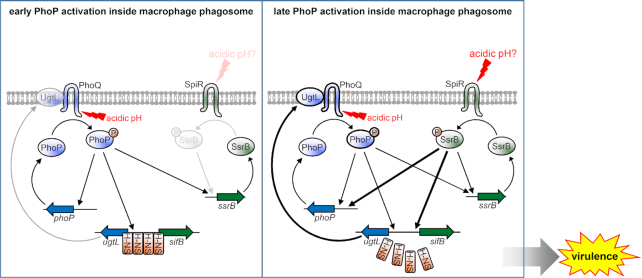Figure 8.
The horizontally acquired ssrB gene activates the ancestral regulator PhoP at late times inside macrophages. (Left) At early times following bacterial internalization by macrophages, phagosomal signals, such as mildly acidic pH, stimulate the ancestral sensor PhoQ to promote the phosphorylated state of PhoP. PhoP-P promotes transcription of its target genes, including the phoP, ugtL, and ssrB genes. The SsrB protein shows little activity at this time. The little ugtL expression taking place is not sufficient for full PhoP activation. (Right) At later times following bacterial internalization by macrophages, SpiR activates SsrB in response to signals yet to be identified, thereby promoting transcription of the ugtL gene by antagonizing the xenogeneic silencer H-NS. UgtL enhances PhoQ autophosphorylation, further activating PhoP. SsrB also increases phoP transcription by directly binding to the purB coding region upstream of the phoP promoter region. As a consequence, PhoP further increases transcription of its activated genes. The SsrB-mediated PhoP activation is necessary for normal Salmonella virulence.

